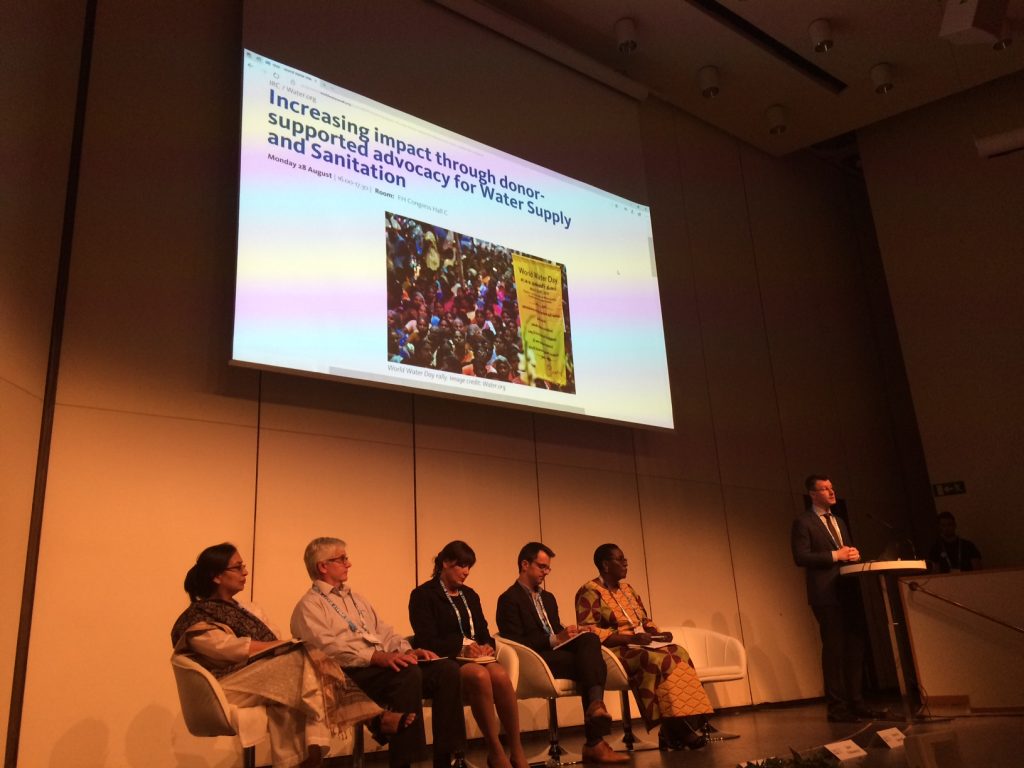Water and waste: reduce and reuse
“Water and waste: reduce and reuse” was the theme of this year’s World Water Week, attended by more than 3,000 in Stockholm. As usual, the topics discussed were wide-ranging. The following are some that caught my attention.
Back to the future
Non-networked solutions and approaches, like fecal-sludge management services, have captured the imagination and interest of the water, sanitation and hygiene (WASH) sector, not least because they offer a viable, interim step towards the ‘safely managed’ goals of U.N. Sustainable Development Goal 6 (SDG6). While non-networked urban sanitation has been at the margins of the industry for 20+ years, I’d argue a tipping point has now been reached, and it was noticeable how donors, government and others crowded onto this topic. From the work a few years back around Excreta Flow Diagrams (EFDs), which seek to diagnose bottlenecks by mapping flows of fecal waste in a city, the focus has now shifted to mainstreaming Fecal Sludge Management (FSM) services into policy, regulation and, by-laws (Warangal City, India is a good example of how monitoring FSM service providers is now written into local municipal by-laws).
Smart subsidies, smarter finances
Harmonized and sequenced financing for WASH was pointed to as a precondition for success in the sector. This seemed to reopen discussion about the management of public financing in the sector, where most effectively to target subsidies, and how best to incorporate private financing into service provision in a way that opens up opportunities for public financing instruments. Amongst others, the World Bank was forcefully arguing for blended financial approaches to reach the SDG6 goal – in short, a creative combination of commercial and concessional financing.

WaterWise cities
Urban water scarcity, resilience to extreme weather events, and a push for integrated urban water management remained high on the technical agenda at Water Week. The principles of WaterWise cities were referenced repeatedly. For those advocating this, it means nothing less than ensuring water is integrated in city planning and design to increase resilience to climate change and improve livability, efficiencies, and a sense of place for urban communities. Ben Furmage at the Cooperative Research Center (CRC) for Water Sensitive Cities showed that Australian experience remains at the cutting edge in this space. The International Water Association’s 17 principles of WaterWise cities offered practical guidance on what water practitioners need to do and how and when they can do it.
Green is the new grey
There is a steady if slow recognition by policy makers that ecosystems can be viewed as green infrastructure (GI) that generates economic gains, supports water supply quantity and quality, and helps reduce water-related disasters. The blending of green and grey infrastructure in practice is supported by more and better economic valuation of GI and examples of positive integration of green and grey into national planning processes. In Stockholm, much of the discussion on this subject pivoted around the need to harmonize language – GI is relatively new in engineering circles – and to find better ways to monitor the benefits of GI (given its generally fragmented/dispersed siting).
City Wide Inclusive Sanitation
One current trend in the WASH sector relates to better planning for urban sanitation service provision. SDG6 will not be met without a concerted approach to service provision in small towns and the informal parts of larger cities. City Wide Inclusive Sanitation (CWIS) addresses this need by calling for sanitation professionals to, if I can adapt a famous John F. Kennedy quote, “Ask not what our city can do for our sanitation program, but ask what our sanitation program can do for our city.” The focus is thereby on delivering sustainable cities (SDG11) with a contribution from sanitation initiatives (SDG 6). For sanitation professionals, this means blending both conventional and new solutions in innovative ways, considering both reticulated and onsite approaches, taking account of the needs and resources of customers, including the poor, and linking sanitation solutions to broader urban development priorities. The CWIS initiative is debunking myths and asking that urban development professionals better coordinate their mandates across the city – incorporating sanitation into land use planning (i.e. housing, drainage, solid waste and other programs) more effectively. Watch this space.






